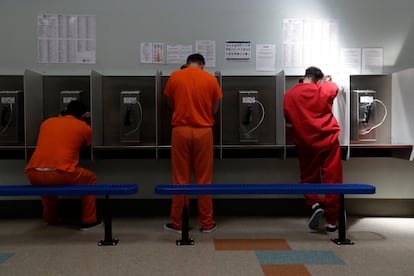HRW calls on the US to end solitary confinement in migrant detention centers
The international organization says that prison authorities are keeping 122,000 people in isolation for at least 22 hours a day

The non-governmental human rights watchdog Human Rights Watch (HRW) has criticized the United States government for allowing the use of solitary confinement in its prisons, and in particular in immigration detention centers, where detainees have been held in isolation for periods of time that the U.N. considers torture. The international organization not only called for an end to solitary confinement, but also to gradually abolish the process of detaining undocumented immigrants. “Imposing solitary confinement is an extreme deprivation of rights that is disproportionate to any legitimate state interest in the immigration detention context,” states HRW.
The call comes the same month that detainees in two U.S. Immigration and Customs Enforcement (ICE) facilities in California, run by the GEO Group, began a labor and hunger strike to protest the living conditions they are subjected to while awaiting deportation. The detainees at Golden State Annex in McFarland, 130 miles from Los Angeles, and those at Mesa Verde in Bakersfield denounced the standards of medical care and food, their isolation due to the end of free phone calls and the use of solitary confinement.
Relatives and former detainees had planned to protest this week outside ICE offices in San Francisco over the treatment they received in these detention centers. The hunger strike ended for health reasons, according to the California Collaborative for Immigrants Justice (CCIJ). Edwin Carmona Ruiz, from CCIJ, condemned the use of solitary confinement, arguing that private companies that manage prisons use solitary confinement to silence protests.
HRW says that nationwide, prison authorities hold about 122,000 people in solitary confinement for 22 hours or more a day. Between 2018 and 2023, ICE has detained more than 14,000 migrants in solitary confinement. That’s according to a report from Physicians for Human Rights (PHR) in collaboration with the Harvard Immigration and Refugee Clinical Program (HIRC), based on government data obtained thanks to the Freedom of Information Act.
These two organizations were able to confirm that the average time in solitary confinement in ICE facilities was 27 days, which exceeds the 15-day threshold that the U.N. experts consider a form of torture. Holding children or people with psychological disabilities in solitary confinement is also a form of torture, no matter how long it lasts.
According to the PHR report, in several hundred cases, a detainee was held in solitary confinement for at least 90 days, and in 42 cases, it lasted more than a year. Many of these cases involved people with mental health problems, who are often subjected to this regime as a disciplinary measure for minor infractions or as reprisals for protests regarding their treatment in detention.
“The treatment of people in immigration detention facilities and the excessive, punitive use of solitary confinement is not only contrary to ICE’s own policies and guidance but also violates U.S. constitutional law and international human rights law,” PHE states in the report’s conclusions on what they describe as a degrading form of treatment.
The Human Rights Watch call also warns that the use of solitary confinement disproportionally affects Black immigrants, especially Caribbean and African immigrants, and aggravates the effects of traumatic experiences. “Segregation” — the term used by ICE — worsens mental health and increases the risk of suicide.
The NGO also calls for immigration detention to be used as a last resort, and recalls that the U.N. Working Group on Arbitrary Detention has long called for an end to the detention of people who are in deportation proceedings.
The United States has had Alternative to Detention (ATD) programs since 2004 that allow non-citizens to remain in their communities, continue to attend to family obligations and prepare for immigration proceedings. According to data from Syracuse University, ICE has 37,004 people in detention facilities as of July 2024 and 177,670 families and individuals in ATD and monitoring programs.
The data from Syracuse University found that from the beginning of the Biden administration until the end of 2022, 377,980 people have been under this type of monitoring and ATD regime. Since the beginning of 2023, these numbers began to fall and are now at one of their lowest point since January 2022, a drop that coincides with the US. government’s recent decisions to limit asylum at the U.S.-Mexico border.
Sign up for our weekly newsletter to get more English-language news coverage from EL PAÍS USA Edition
Tu suscripción se está usando en otro dispositivo
¿Quieres añadir otro usuario a tu suscripción?
Si continúas leyendo en este dispositivo, no se podrá leer en el otro.
FlechaTu suscripción se está usando en otro dispositivo y solo puedes acceder a EL PAÍS desde un dispositivo a la vez.
Si quieres compartir tu cuenta, cambia tu suscripción a la modalidad Premium, así podrás añadir otro usuario. Cada uno accederá con su propia cuenta de email, lo que os permitirá personalizar vuestra experiencia en EL PAÍS.
¿Tienes una suscripción de empresa? Accede aquí para contratar más cuentas.
En el caso de no saber quién está usando tu cuenta, te recomendamos cambiar tu contraseña aquí.
Si decides continuar compartiendo tu cuenta, este mensaje se mostrará en tu dispositivo y en el de la otra persona que está usando tu cuenta de forma indefinida, afectando a tu experiencia de lectura. Puedes consultar aquí los términos y condiciones de la suscripción digital.
More information
Archived In
Últimas noticias
David Bowie, the galactic thinker who encouraged us to break new ground
John Berger and the loss of rural culture
From police officer to bloodthirsty kidnapper: Terror in Mexico during the years of ‘The Ear Chopper’
Alain Aspect, Nobel laureate in physics: ‘Einstein was so smart that he would have had to recognize quantum entanglement’
Most viewed
- David King, chemist: ‘There are scientists studying how to cool the planet; nobody should stop these experiments from happening’
- Reinhard Genzel, Nobel laureate in physics: ‘One-minute videos will never give you the truth’
- Oona Chaplin: ‘I told James Cameron that I was living in a treehouse and starting a permaculture project with a friend’
- Mexico completes its trade shift with the entry into force of tariffs on China and countries without trade agreements
- Sinaloa Cartel war is taking its toll on Los Chapitos










































